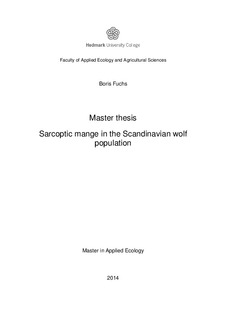| dc.description.abstract | Sarcoptic mange, a parasitic disease caused by the mite Sarcoptes scabiei, is epidemic in red foxes Vulpes vulpes and reported on wolves Canis lupus in Scandinavia. The small, inbred wolf population of Scandinavia might be particularly susceptible to sarcoptic mange. I address the questions of how this parasite is distributed and transmitted within the recovering wolf population.
A total of 198 serum samples, collected over 15 years from 141 captured Scandinavian wolves were tested for antibodies against S. scabiei by enzyme- linked immunosorbent assay (ELISA). This data was correlated with ecological data on the individual, pack and population scale. Additionally, necropsy reports of 269 wolves were used in the study. I tested whether individual, intrinsic characteristics such as body condition, age, inbreeding coefficient, and reproductive state or extrinsic density factors such as wolf pack density, pack size and habitat productivity fit the given data better by using generalized linear regression models selected by AICc.
Among the captured wolves, I found a temporal declining mean seroprevalence of 11.1% (SE = 2.5%), and a higher probability of finding seropositive wolves in the southern part of their distribution. Females had a lower probability than males of contracting mange, and the sex difference decreased with increasing pack size. No wolf pup (N=56) was seropositive at capture. Additionally, I report recovery from mange on adult wolves. Mange-caused mortality was limited, and starvation was the most common cause of death reported from necropsy.
I conclude that sarcoptic mange has a small potential negative effect on the recovery of the Scandinavian wolf population. More support for intrinsic than wolf density factors and a heterogenic distribution of mangy animals on pack scale, suggest low probability of wolf-to-wolf transmission of S. scabiei in Scandinavia. | nb_NO |
